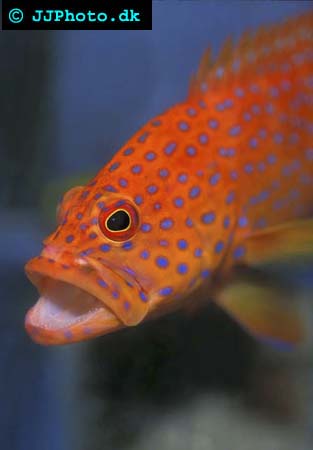Basses
A lot of fish species both freshwater and marine are popularly referred to as basses even though most of them aren't really bass fish: true basses are fish found in the family Serranidae. Fish like rainbow bass, large mouth bass and smallmouth bass are not basses.
The family consist of 64 genuses that altogether contain about 450 species. The family contains everything from small basslets to large groupers and basses. One of the smallest know species in the family is Serranus subligarius, the belted sandfishwhich grows to just over 4 inch, 10 cm. The largest member of the family is the Epinephelus itajara, commonly only called itajara which can grow to almost 95 inches, 240 cm in length and weigh 300 kg (660 lb). Most bass species are found in saltwater but a few species can be found in freshwater. Bass species can be found worldwide in temperate to tropical seas. Many bass have very attractive coloration and patterning which makes them attractive to keep in aquarium. Their large size is however an obstacle that prevent many species from being kept by most aquarists. Many basses are important and sought after food fish.
The in aquarium most common genuses include Cephalopholis, Epinephelus, Hypoplectrus, Liopropoma, Paranthias and Serranus but members of other genuses are also kept in aquariums. All basses in the aquarium trade are wild caught and very little / nothing is known about breeding them in aquariums. Most species are hardy and can adapt to a wide variety of aquarium conditions as long as the water quality remains good. Most species are reclusive and aggressive. I.e. they spend a lot of their time hidden and the rest bullying other fish. This behavior makes it very important to provide them with good caves. You can only keep one bass in the same aquarium as they are solitary and territorial. The exception from this rule is Tukas which do well in groups. Other than this the preferred setup and aquarium size depends on the exact species you want to keep.
All bass species are predatory and consider any fish that will fit into their mouth food. Most species are easy to feed and will accept live as well as frozen foods and pellets although they sometimes have to be trained to accept your food. It is very important to give your basses a good and varied diet if you want them to remain healthy.
Basses are hermaphrodites, Simultaneous or synchronous. Some species are both males and females while other switch from one gender to the other during their life span. The eggs are released in the pelagic and hatches within 24-48 hours.
Bass Articles:
Harlequin Bass – Serranus tigrinus
Chalk Bass – Serranus tortugarum
Anthias
Aquarium Chillers
Basses
Batfish
Blennies
Butterflyfish
Cardinalfish
Clown fish
Corals
Damselfish
Files
Goatfish
Gobies
Gorgonians
Grammas
Groupers
Grunts
Hawkfish
Jawfish
Jellyfish
Lionfish
Dragonets
Mantis shrimp
Marine angelfish
Marine Catfish
Moray eels
Nudibranch
Octopus
Pipefish
Protein skimmers
Pufferfish
Rabbitfish
Rays
Snappers
Scorpionfish
Sea Anemones
Sea horses
Sea Stars
Shark Fish
Shrimps
Snails
Squirellfish
Surgeonfish
Triggerfish
Wrasses

